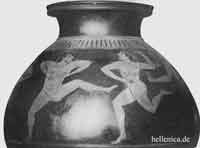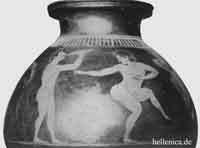.
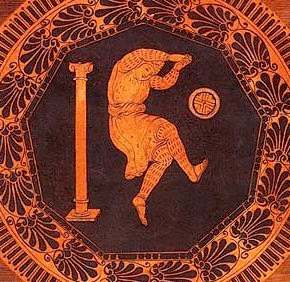
A girl dancing with a ball, from an Attica vase.
The dance also had undergone a wonderful development rhythmically; for even in Homer's time we read in “The Odyssey” of the court of Alcinoüs at Phocæa, how two princes danced before Ulysses and played with a scarlet ball, one throwing it high in the air, the other always catching it with his feet off the ground; and then changing, they flung the ball from one to the other with such rapidity that it made the onlookers dizzy. During the play, Demodocus chanted a song, and accompanied the dance with his lyre, the players never losing a step. Edward MacDowell
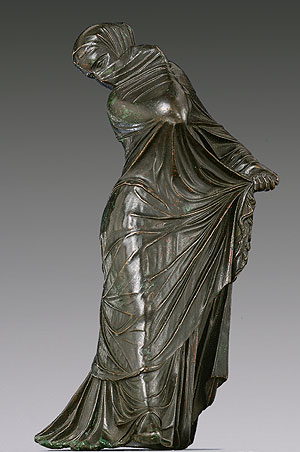
"Baker Dancer", From the Metropolitan Museum of Art, Height 0.21 m, 250-220 BC.
Statuette of a veiled and masked dancer, Hellenistic Greek. Bequest of Walter C. Baker, 1971 (1972.118.95).
The attire worn by all performers of the mantle dance is similar: an ample cloak, enwrapping the body and on some occasions drawn closely over the head, or covering the lower part of the face as well, leaving only the eyes unveiled. This mantle, which is often depicted as extremely thin and transparent, and worn over a long full chiton, becomes the most expressive component of the composition, both concealing and revealing the bodily shape and identity of the dancer. Elisabet Friesländer , The Mantle Dancer in the Hellenistic Period: Glorification of the Himation.
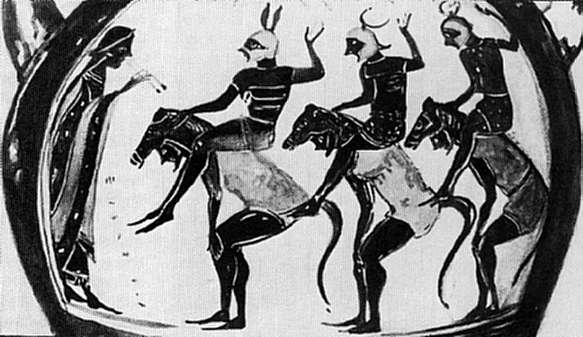
Music and Theater .. some actors as horses..
Animal Dances, persons dancing in animal costumes such as in theater festivals ANIMAL IMPERSONATION
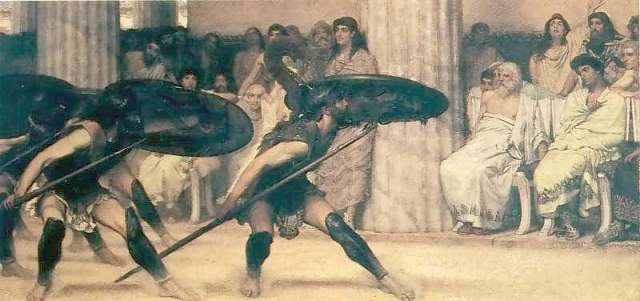
Pyrrhic dance with shields and spears according to Alma Tadema.
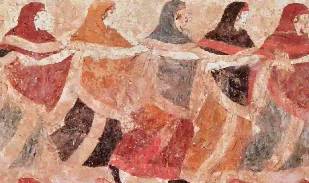
Funeral dance (Threnos), from a Greek Fresco "ital.: Tomba delle Danzantrici" (Apulia) tomb 5th century BC
A interesting and funny description by J. B. Calvert of a story by Herodotus of Cleisthenes, a tyrant of Sicyon in 575 BC, who wanted his daughter Agarista to marry. A large party started with many young rich men from prominent Athenian families who wanted to be considered to marry Agarista. Hippocleides, one of these young men, showed off his talents, which included dancing to the flute. He danced on a table, which was rather showy anyway, but he was finally so indelicate as to dance with his head on the table and his legs gyrating in the air. Cleisthenes rejected Hippocleides to marry his daughter, with the comment that he had "danced" away his bride. Hippocleides replied with "What do I care?" Now underwear were not used commonly by ancient Greeks and we can imagine that even if nudity was not uncommon in ancient Greece the performance of Hippocleides must be shocking. ( Feast of funnies from the ancients )
After 400 years occupation of Greece by the Romans and 1000 years as part of the East Roman Empire (Byzantine Empire) and another additional 400 years Turkish occupation it is not clear what elements of ancient Greek dance survived in the modern Greek folk dance. Nevertheless it is probably that various elements of ancient Greek dance survived mixed with elements from other cultures. One example is the dance Ageranos assumed to be related to the Geranos.
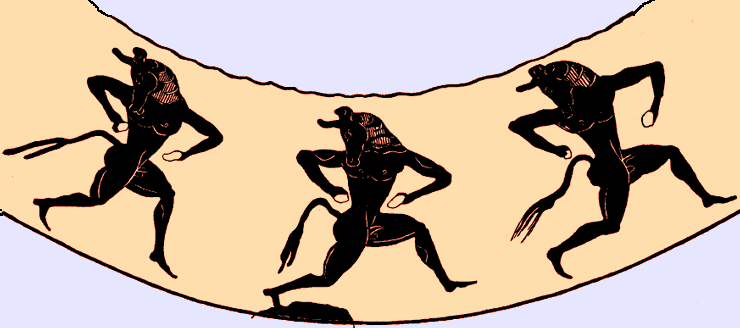
A dancing Minotaurus?
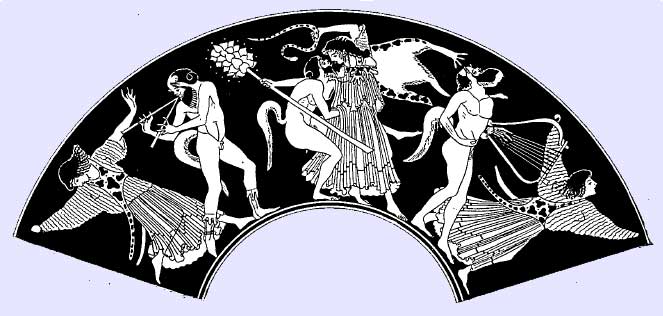
Maenads dancing (reminds the modern "Syrtaki" dance), Brygos Cabinet des Medailles, Paris
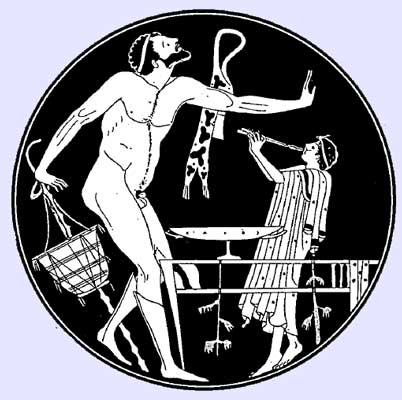
Dancing man while a boy plays the double flute, Brygos Painter, Faina Orvieto
Socrates
Callias: O Socrates, do please invite me when you begin your dancing lessons. I will be your vis-a-vis, and take lessons with you.
Socrates: Come on (the jester shouted), give us a tune upon the pipe, and let me show you how to dance.
So saying up he got, and mimicked the dances of the boy and girl in burlesque fashion, and inasmuch as the spectators had been pleased to think the natural beauty of the boy enhanced by every gesture of his body in the dance, so the jester must give a counter- representation, in which each twist and movement of his body was a comical exaggeration of nature. Xenophon Symposium
QUOTATIONS
..My soul is like a battlefield of Apollo, Dionysus, Christ, Nietzsche and Richard Wagner ...
...A dancer, if she is great, can give to the people something that they can carry with them forever. They can never forget it, and it has changed them, though they may never know it. Isadora Duncan
Isadora Duncan Dancing in an Amphitheatre in Athens
Plato said that dancing (orchesis) "was the instinctive desire to explain words by gestures of the entire body"
“The Eleusinians have a temple of Triptolemus, of Artemis of the Portal, and of Poseidon Father, and a well called Callichorum (Lovely dance), where first the women of the Eleusinians danced and sang in praise of the goddess
The third branch from the straight road is on the right, and leads to Caryae (Walnut-trees) and to the sanctuary of Artemis. For Caryae is a region sacred to Artemis and the nymphs, and here stands in the open an image of Artemis Caryatis. Here every year the Lacedaemonian maidens hold chorus-dances, and they have a traditional native dance.
On their market-place the Spartans have images of Apollo Pythaeus, of Artemis and of Leto. The whole of this region is called Choros (Dancing), because at the Gymnopaediae, a festival which the Lacedaemonians take more seriously than any other, the lads perform dances in honor of Apollo.
Going forward about a stade from the grave one sees traces of a sanctuary of Artemis, surnamed Cordax because the followers of Pelops celebrated their victory by the side of this goddess and danced the cordax, a dance peculiar to the dwellers round Mount Sipylus.” Pausanias
I desire to hire from you Tisaïs, the dancing girl, and another, to dance for us at our festival of Bacchias, for fifteen days from the 13th Phaophi by the old calendar. You shall receive as pay 36 drachmai a day, and for the whole period 3 artabai of wheat, and 15 loaves; also, three donkeys to fetch them and take them back. Letter of Aurelius Asclepiades to Aureleus Theon, c. 295 AD, Paul Halsall Ancient History Sourcebook: Accounts of Personal Religion, c. 430 BCE - 300 AD
Girls were required to run and exercise so that their babies would grow in strong and healthy mothers. To make them brave, Lycurgus ordered that occasionally the girls had to dance and sing naked in front of all the young men. Therefore the girls were ashamed to be fat or weak, and they were happy to display their beauty to such an appreciative audience. In their songs, the girls praised the men who were brave and strong, and they made fun of those who were weak and cowardly, so they sharpened the men's love of glory and fear of shame. Plutarch, Lycurgus, The Father of Sparta
According to Athenaeus after the Marathon battle Sophocles celebrates the victory dancing and playing the lyre completely nude (others say that he was wearing a himation).
Images
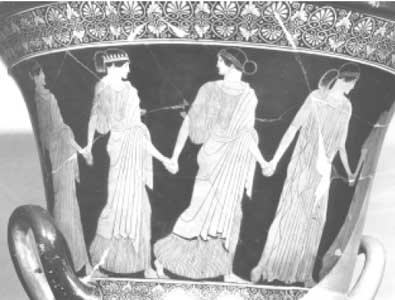
Dancers of a partheneion (song by chorus of maidens). Red Figure krater by Villa Giulia Painter in Rome. c. 450 BC. William D. Furley and Jan Maarten Bremer, Selected Cult Songs from the Archaic to the Hellenistic period.
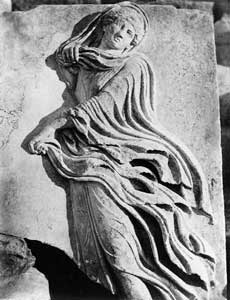
Dancing Girl, Relief
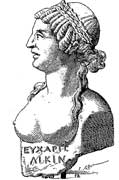
Eucharis, Greek slave of Licinia, professional dancer in Rome, died when she was 14 years old
Remains of pottery cups from Brauron portraying dancing arktoi, from the Arkteia or Bear Festival at Brauron
Terracotta Dancer from Tanagra (Greece)
Other Images

![]()
Greek Girl Dancing
Leighton, Frederic, Lord
Buy this Giclee Print at AllPosters.com
References
J. B. Bury, A History of Greece (New York: The Modern Library, no date). p. 148.
H. L. Crosby and J. N. Schaeffer, An Introduction to Greek (Boston: Allyn and Bacon, 1961). p. 89.
LINKS
Traditional Dance in Greece today
Classical Greek Dance Association
Gallery of Isadora Duncan dancing
The Delphic Games Revival (See the Macedonian Dancers)
Rita Hayworth as Terpsichore with other Muses
The Dancing Of Ancient Egypt And Greece Published 1924
THE ROLE OF DANCE IN THE ANCIENT AND MODERN OLYMPICS (PDF File)
Reports in Greek
Lucian, On Dancing (Περί Ορχήσεως / De Saltatione) (Greek Text)
Ο ΑΡΧΑΙΟΕΛΛΗΝΙΚΟΣ ΠΟΛΙΤΙΣΜΟΣ, ΥΠΟΤΟΜΕΑΣ: ΜΟΥΣΙΚΗ-ΧΟΡΟΣ-ΘΕΑΤΡΟ
| Ancient Greece
Science, Technology , Medicine , Warfare, , Biographies , Life , Cities/Places/Maps , Arts , Literature , Philosophy ,Olympics, Mythology , History , Images Medieval Greece / Byzantine Empire Science, Technology, Arts, , Warfare , Literature, Biographies, Icons, History Modern Greece Cities, Islands, Regions, Fauna/Flora ,Biographies , History , Warfare, Science/Technology, Literature, Music , Arts , Film/Actors , Sport , Fashion --- |




